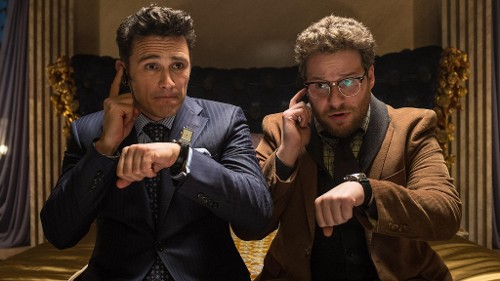BBC - Doctor Who Classic Episode Guide - The Enemy of the World - Details
Season 5, Story 4 (Overall Series Story #40) | Previous - Next | Index
Are "Enemy" and
"Web of Fear" the last of the lost episodes we'll ever see recovered? I don't know if bookmakers have odds on another story turning up, or if there are rumors out there I just haven't heard yet ... but my sense is it's not very likely. Based on what we got with 2013's surprise discoveries though, here's hoping more are stashed away somewhere just waiting to be recognized for what they are.
Salamander is one of the most intriguing villains the show has ever had. It helps that he's played by Patrick Troughton, who is excellent here in his dual roles. But it's not just the novelty and Troughton's charm, it's how sinister Salamander is and how, despite being a mere human, he manages to penetrate the TARDIS and seems to be within a hair's breadth of carrying off his impersonation of the Doctor long enough to be the one who survives at the end. To the extent this story is
Doctor Who does
James Bond, he's every bit the Bond villain for most of the story, but he's something a bit more complicated. He's not just got a secret lair where his tech comes from, he's running a con on the world at large and on his own his own scientists and lackeys.
And it's the fact all his power comes from a con, which is basically just a story, that makes his super-power, if you will, storytelling. It's not that he can cause earthquakes and volcanoes, it's how he got to wield that power that turns out to be so fascinating. It's why confidence tricksters make such brilliant villains -- think Verbal in
The Usual Suspects -- because they're schemes are so high-risk/high-reward; they're always on the verge of being revealed as frauds, even while they're amassing tremendous klout.
"Enemy" takes a bit of a beating in the critical judgments found on the official BBC site, but is
adored by Sandifer and hailed as one of the best stories produced. Sandifer, here I am being a critic fanboy again, is much closer to the truth, I think, than
The Discontinuity Guide. For one thing, in a season of Base-Under-Siege stories that, frankly, get so tedious it makes them almost impossible to watch on my late-night viewing schedule. Sandifer's analysis keys in on how the narrative subverts the action-adventure tropes, but may over-emphasize the degree to which it does, at least intentionally. This story feels very much like a deliberate attempt to do
James Bond &
The Avengers where the subversive elements are introduced by necessity of the six-part story structure and the limits of budget. That the end effect is what Sandifer describes I won't dispute, but I suspect it's a happy accident ... the kind which probably only happen to secret geniuses like he argues David Whitaker (this story's writer) is ... that resulted in the brilliant outcome.
Griffin the cook is rightly lauded (universally -- as far as I can tell) as a sublime addition to the story. It's this sort of anarchic playfulness of storytelling style that so few shows even attempt to pull off that adds depth to the whole affair. It looks so quintessentially British to my American eye to have a character so comedically cynical just sort of tossed into the mix. Why don't we see more Griffins on TV?
Let's talk for a moment about the women in this story. There's Victoria, who I don't much care for as a companion, but she and Jamie get to go on a dangerous mission without the Doctor to investigate Salamander. Actually, what the hell were they thinking sending those two on a dangerous mission?! For crying out loud. They don't even know what a helicopter is and they're in a 1960s era spy story of the near future positively littered with helicopters! Still, they acquit themselves admirably, for the most part, and it's not too distracting that they're totally unequipped to do what's asked of them.
Then there's Astrid, who is the Bond women of this story. Sort of. Mercifully she's the action aspect of that role, not the dubiously oversexed aspect. No mere eye candy, sixties era Bond girl here. Not only is she more Bond that Troughton's Doctor, the Doctor is more Bond girl than she is! Watch him frolicking around the shore in his skivvies and marvel at the role reversal. That inversion may be my third favorite thing about this story.
Unless Carmen Munro as Fariah is the next best thing. Forty stories in and I gather from Sandifer's post this is the first black woman to appear on the show. We're still miles away from this being a coup for civil rights, Patrick Troughton ruddied up to play a Mexican villain is hardly a step forward here, but at least he's no
Toberman.
The near-future of this 1967-filmed story is practically today. Not exactly recognizable when compared to the real world, or really any other 21st century
DW stories either, but that's OK. Continuity is a sucker's game in this universe. The travel between locations is not depicted very effectively, nor does the editing help. I wondered several times where the heck people were, and how they changed continents so suddenly, or if they did.
Small trivia note: Patrick's son, David, has a small role as guard in "Enemy," but he's got a much larger role as King Peladon in
"The Curse of Peladon" which, quite coincidentally, I just watched as well, so he'll get mentioned again shortly.












